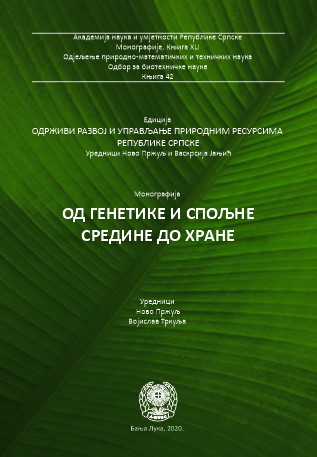Forage legumes in agricultural production systems
DOI:
https://doi.org/10.7251/EORU2001313SKeywords:
Combined crops, forage yield, grain yield, legumes, plant proteins, sustainable agricultureAbstract
In order to increase and intensify of livestock production, the solution should be found in high-yielding plant species of good quality, which fit into the system of continuous production of animal feed. Together with efforts to reduce energy consumption, environmental pollution, intensify sustainable agriculture systems and maintain biodiversity, the possibility of increasing areas under forage legumes should be considered. As nitrogen fixers, these plants are minimally fertilized with nitrogen fertilizers whose residues in soil are lost by leaching, causing pollution of groundwater as well as surface watercourses. The diversity of their use, high and stable yield and quality of products, make these plants important in solving problem of deficit of protein-rich animal feed. From the group of perennial forage legumes, the representatives with the greatest economic and agrotechnical importance are: blue alfalfa, sickle medick, hybrid alfalfa, black medic, red clover, white clover, birdsfoot trefoil, greater bird's-foottrefoil, narrow-leaved bird's-foot-trefoil, common sainfoin, white sweet clover and yellow sweet clover. In the group of annual forage legumes that are grown or may be of interest in modern forage production systems belong to: vetchs, forage peas, broad bean, lupins, soybeans and cowpea. Besides until recently, far more cultivated species such as lentils, grass pea and bitter vetch, positive results of preliminary experiments with species such as pigeon pea, white lupin, narrowleaf lupin, narbon bean and cowpea, indicate the possibility of their introduction into livestock production systems and / or green manure. Forage legumes are grown in Republika Srpska on about 50,000 ha as pure crops, often as combined crops with perennial or annual grasses, other legumes or plants from other groups. Growing combined leguminous crops and grasses or cereals can provide many benefits, such as: increased biomass yield and utilization of soil resources, increased yield stability, improved nutrient, water and light utilization, as well as weed, disease and pest control. In the temperate climate zone, this way of cultivation is far more successful when used in forage production compared to grain production. Today, as in the previous period, there is a need for species and cultivars of forage legumes, which in addition to with high yield potential, will have improved grain / forage quality, as well as increased resistance to stress, especially stress caused by lack of soil water, high temperatures and increased solar radiation. The economy of production of legumes at the farm level is often misjudged as negative, because they generally do not take into account the positive, economically currently invisible, advantages in growing legumes. Prices of protein feed underlying the intensive production systems in the future will continue to rise, so that in the near future, cultivation of legumes and be cost effective than most other agricultural plants. The benefits of cultivating legumes and their impact on the advancement of agroecosystems have been for a long time. The introduction of legumes into production systems would limit the increasing degradation of land. In order to develop sustainable agriculture, market policy should recognize the value of products obtained from leguminous plants by certain agrarian policy measures.
